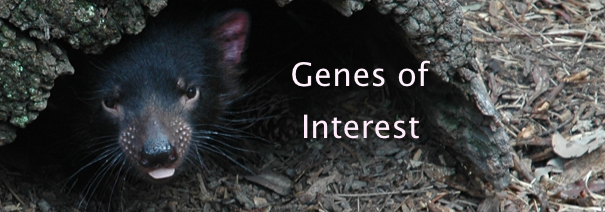The main goal of this project was to gather data about the genome diversity among Tasmanian devils, and thereby to inform decision-making about conservation of the species. As a side-benefit, the data we gathered are potentially useful for identifying differences related to an individual devil's resistance to DFTD. In addition to sequencing two devil's, we sequenced a tumor sample. Differences observed between the tumor and normal tissues can suggest possible causes of the cancer, though in the case of DFTD, these inferences are particularly problematic (as compared to, say, differences between a human tumor and normal cells from the same individual) because the tumor's underlying genomic characteristics are inherited from the genome of a long-dead individual. Still, our data can be mined for clues about the genetic basis of DFTD, as we now illustrate, starting with a review of some basic concepts about cancer. A number of other observations about gene variants are presented in the paper's supplementary material. Please keep in mind that validation of any such hypothesis will require very demanding experimental studies.
The reciprocal interaction of gene expression and environmental conditions results in a set of characteristics that are particular to individuals, populations and species. A mutation is a change in the genome of an individual or a group of individuals. While most of mutations are not expected to strongly modify the common characteristics or function of an organism, some mutations have the potential to do so. In particular, changes modifying the normal working of the cell cycle (a process by which cells duplicate) can result in abnormal cell reproduction. If a group of abnormal cells duplicate faster than normal cells, they will eventually reach a higher proportion and distort the normal working of the tissue they are part of. This pathology (known as cancer) can have different origins. For example, skin cancer can be the result of a mutation in a gene coding for a protein coordinating the start of cell duplication, or another in an enzyme synchronizing the end of cell cycle.
It has been found that the Tasmanian Devil cancer (DFTD) is easily transmissible between individuals because their immune system cannot recognize these abnormal cells. This is unlikely to happen between individuals of a species with higher genetic diversity, since their immune system would detect anomalous cells in a higher number of different ways. In our study, we looked in a tumor from a Tasmanian devil for mutated proteins that could be responsible for the uncontrolled multiplication of cells. We found mutations in three different genes that might underly the facial tumor disease. These genes were PRKCH, CCNA-like (coding for cyclin A-like), and GALNS.
The skin of mammals is made of different cell layers. Cells are produced in the innermost of these layers and migrate towards the surface while they acquire keratine, become flat and die. In one of this layers (called the granular layer), PRKCH produces an enzyme that senses cellular signals (calcium and phorbol esters), stops cell reproduction, and stimulates their differentiation into flat cells with keratin (keratinocytes). In this way, normal PRKCH is expected to control skin cell multiplication while an anomalous PRKCH can result in cancer. This is what we think may be happening in tumor cells of the Tasmanian devil. To be slightly more precise, the enzyme coded by PRKCH controls cell multiplication by catalyzing a set of chemical reactions. The structural part of this enzyme in charge of catalysis (a very small part of it) has a mutation in the tumor sample we sequenced, which potentially results in inefficient chemical reactions and then an uncontrolled cell reproduction.
In the skin of mammals, cell multiplication is finely controlled by the action of some proteins. For example, DNA replication occurs when high amounts of a protein called cdk2 are present and active in specific subcellular locations. If high amounts of this protein remain active for a long time, DNA multiplies more times than expected and cells keep dividing with no control. This may be happening in DFTD. cdk2 activates DNA replication in association with two different proteins: cyclin E and cyclin A. cyclin A can independently repeal the active cdk2 from the DNA and stop its replication. We think that the mutated cyclin A-like protein of tumor cells may be able to activate cdk2, but unable to efficiently repeal its active forms. This would mean that active cdk2 remains present around the DNA for a longer time, extending its replication. In turn, this would result in an abnormal cell growing, and later in cancer (see the Animation button, below).
Finally, we propose the hypothesis that two metabolic products (keratan sulfate and chondroitin sulfate) are not being efficiently eliminated in tumor cells due to a mutation in the gene GALNS. The aberrant accumulation of these products would result in their further abnormally high incorporation into proteins. This can result in an aberrant regulation of particular cellular growth factors that might result in cancer or a more aggressive form of cancer.
